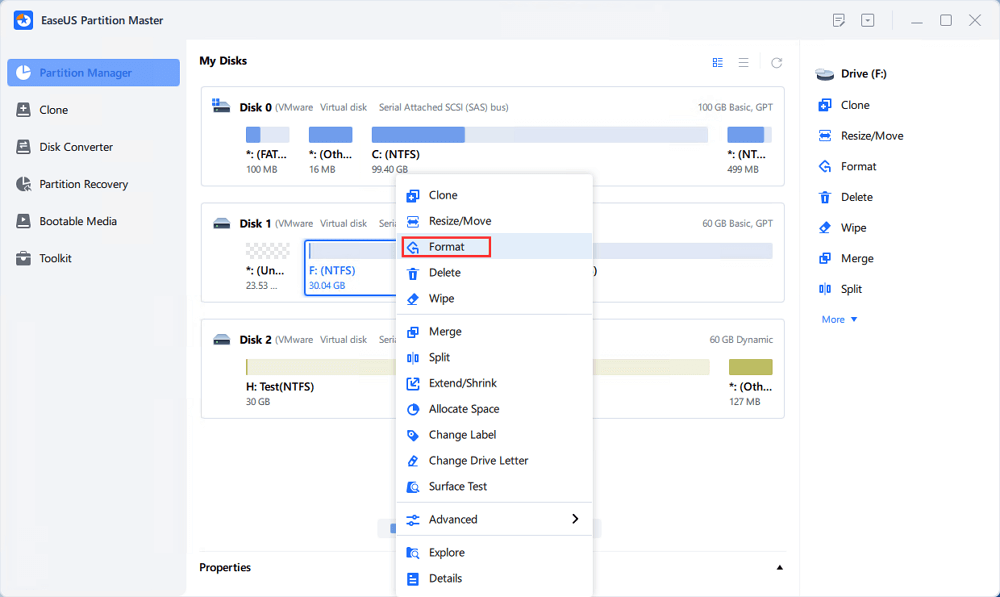How to Format Bitlocker Encrypted Drive Using CMD
Cici updated on Apr 01, 2025 to Partition Master | How-to Articles
In this guide, you'll learn how to format a BitLocker-encrypted drive using CMD. Discover step-by-step instructions, tips, and alternative methods to handle BitLocker drives effectively.
| Comparison | 🏆EaseUS Partition Master | 🏅CMD |
|---|---|---|
| ⏰Duration | 10 Minutes | 20 Minutes |
| 👨🔧Who USe | All level of users | Experienced users |
| 💻Difficulty Level | Low | High |
| 🐾Total Steps | 4 steps | 5 steps |
Windows has a strong feature called BitLocker encryption, which adds additional security to your data. However, formatting a device secured with BitLocker can seem complicated, particularly if you prefer to use command-line tools. This tutorial will utilize CMD to format a BitLocker drive, making the procedure easier for beginners and trained users.
EaseUS will demonstrate how to format a BitLocker-encrypted drive using the command prompt. and another reliable tool. Let's get started on the precise procedures you can use to use CMD to format your BitLocker drive.
EaseUS Partition Master Free is the simplest method if using CMD to format a BitLocker-encrypted drive seems overly complicated. A reliable substitute for the command prompt approach, this professional disc management program allows you to format a BitLocker-encrypted drive without requiring a password or recovery key.
It offers a hassle-free approach to handling your encrypted discs by removing the need for technical knowledge with a straightforward and understandable interface.
Here's a quick guide on formatting a BitLocker-encrypted HDD using this tool:
Step 1. Run EaseUS Partition Master, right-click the hard drive partition you intend to format and choose "Format".

Step 2. In the new window, set the Partition label, File system (NTFS/FAT32/EXT2/EXT3/EXT4/exFAT), and Cluster size for the partition to be formatted, then click "OK".
Step 3. Then you will see a warning window, click "Yes" in it to continue.
Step 4. Click the "Execute 1 Task(s)" button to review the changes, then click "Apply" to start formatting the partition on your hard drive.
Aside from BitLocker drive formatting, EaseUS Partition Master offers other helpful features when handling encrypted discs or performing sophisticated disc management tasks:
We highly advise using EaseUS Partition Master for a simple approach to handling BitLocker-encrypted devices!
This section will cover how to use CMD to format a drive encrypted with BitLocker. This approach provides a simple way to manage your encrypted drives without depending on other programs, even though it could look more sophisticated. You may easily format a BitLocker drive using CMD by following the instructions below.
Follow these steps to format the BitLocker encrypted drive via CMD:
Step 1. Press the Windows key and enter "cmd," right-click "Command Prompt" and select Run as administrator. This ensures that you have authorization to run the commands.
Step 2. Choose the drive letter of the BitLocker-encrypted drive you want to format. Type "diskpart" in the Command Prompt and hit Enter. List available drives with this command: list volume
Step 3. Unlock the encrypted drive before formatting. The following command unlocks the drive using the BitLocker recovery key: X manage-bde-unlock: RecoveryPassword YOUR-KEY
Change "X:" to the encrypted drive letter and "YOUR-RECOVERY-KEY" to the BitLocker recovery key.
Step 4. Unlock the drive and format the drive using this command: format X: NTFS
"X:" is the drive letter of the BitLocker-encrypted drive, and you choose NTFS as the file system (you can also use FAT32).
Step 5. After formatting, type the list volume to check. Depending on your choice, check that your drive's file system is NTFS or FAT32.
These guidelines will let you effectively use CMD to format a BitLocker-encrypted drive. This approach is quite helpful if you want complete process control and do not want to use other software. Let's share this guideline with more Bitlocker users on your social media:
For those experienced with command-line tools, formatting a BitLocker-encrypted drive using CMD is reliable. This article provides a simple way for handling encrypted discs as it has led you through the commands required to unlock and format the drive using Command Prompt.
However, we strongly advise EaseUS Partition Master for consumers who want a simpler, more user-friendly approach. With its easy interface and capacity to format BitLocker devices without needing a password or recovery key, it provides a consistent substitute for the CMD approach. Apart from formatting, EaseUS Partition Master has other strong capabilities, including disc resizing, partition recovery, and drive cloning, providing a complete disc management solution.
Try EaseUS Partition Master if you want a simpler, quicker approach to managing your BitLocker-encrypted drives!
This section addresses some common questions if you're dealing with a BitLocker-encrypted drive and need more information about formatting or managing it. The provided answers provide more detailed explanations.
1. How do I force format a drive with BitLocker?
Before forcing a format, you must first unlock a BitLocker-encrypted drive with the recovery key. Access and drive formatting require disabling or circumventing BitLocker encryption.
To drive using the forced format:
Even in encrypted mode, this method formats disc.
2. How do I bypass BitLocker to format the drive?
With unlocking the drive, bypassing BitLocker is easier. Decrypt or unlock the drive before formatting.
Format the drive without BitLocker:
Formatting is impossible without unlocking the drive because BitLocker encryption protects data.
3. How do I disable BitLocker in Windows?
Drive decryption is needed to disable BitLocker. The Control Panel or Windows settings allow this.
Related Articles
exFAT Converter: How to Convert exFAT to NTFS/FAT/FAT32
How to Repair Windows 10 From USB [Complete Guide]
How Do I Fix Windows 10 BSOD: Blue Screen of Death Error? Here Is The Guide
[Fixed] Can't Write to SD Card on Windows 10/8/7 🔥